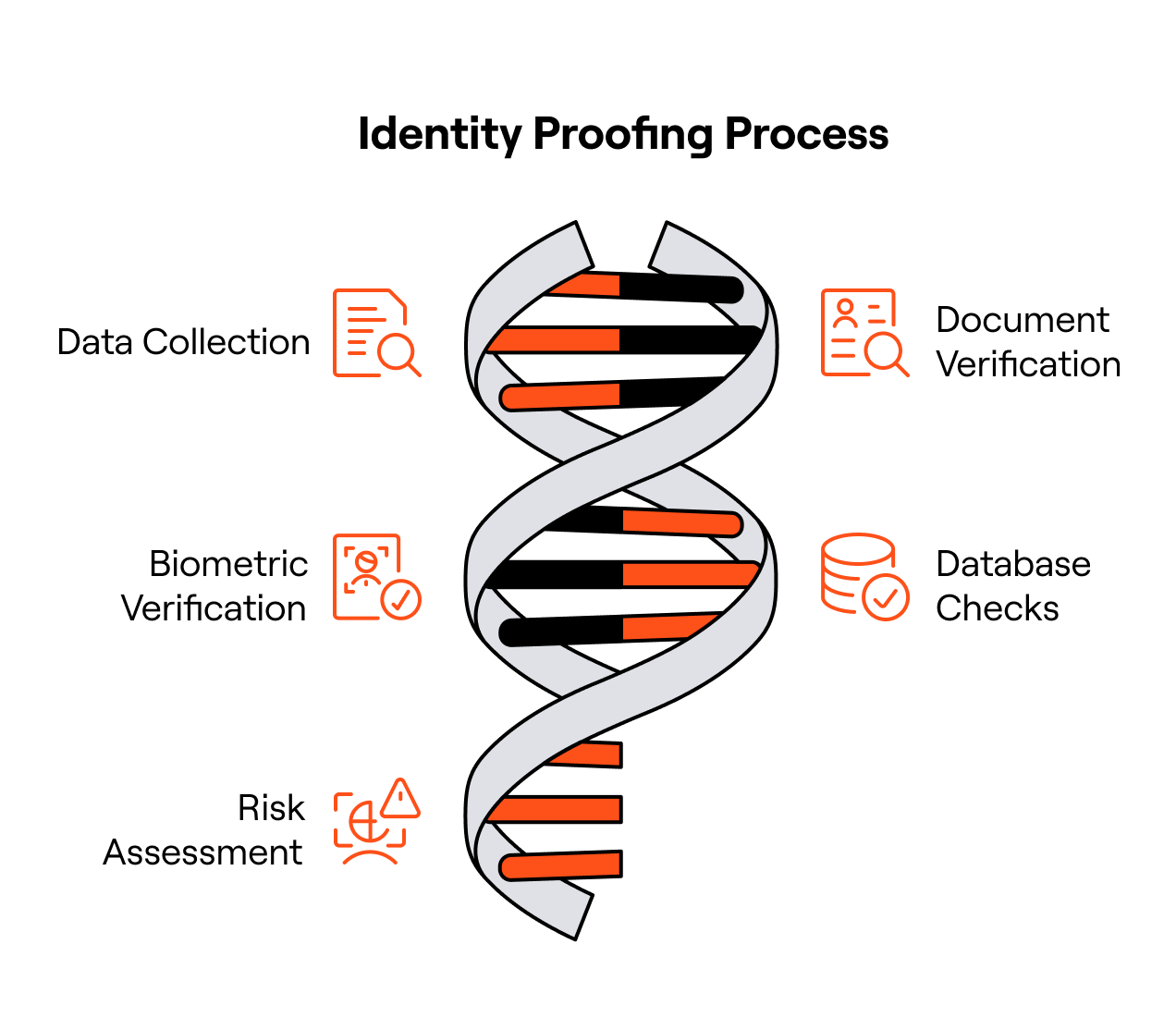What is Identity Proofing and Why is it Important?
Learn what identity proofing is, how it works, and why it’s vital for security, compliance, and trust in digital onboarding and access management.

Table of Contents
Proving that someone is who they claim to be has become one of the most critical challenges in cybersecurity. Identity proofing sits at the heart of that challenge – serving as the process by which systems validate a user’s claimed identity (especially at onboarding) before granting access to sensitive resources. Without thorough identity proofing, threat actors can slip in through synthetic identities, credential fraud, or impersonation, undermining trust across apps, APIs, and systems.
The need for strong identity proofing is more urgent than ever: according to Experian, in 2024, U.S. authorities logged 1,135,270 complaints of identity theft, a 9.5 % increase year over year, with total losses topping $12.7 billion.
These trends underscore how identity fraud is on the rise and highlights the consequences of weak onboarding or lax verification.
In this article, we’ll explain what identity proofing is (and how it differs from verification and authentication), examine how it works, explore common threats and best practices, and look ahead to emerging trends.
What Is Identity Proofing?
In the digital era, organizations rarely meet their users face to face; yet they must be certain those users are who they claim to be. Identity proofing is the process that bridges this trust gap. It’s a foundational step in digital identity management that establishes the legitimacy of an individual’s claimed identity before granting access to systems, data, or services.
At its core, identity proofing combines data validation, document verification, and behavioral analysis to confirm that a person truly exists and that their provided identity details are genuine and belong to them. It’s often the first stage in an organization’s identity lifecycle, forming the basis for secure user onboarding, account creation, and access management.
How Identity Proofing Differs from Verification and Authentication
Identity proofing is frequently confused with identity verification and authentication, but each serves a distinct purpose.
- Identity proofing occurs during onboarding – it’s about confirming the authenticity of an identity claim before trust is established.
- Identity verification is a part of proofing but focuses specifically on validating the documents, data, or biometrics used to support that claim.
- Authentication, on the other hand, happens after proofing. Once an identity has been verified, authentication ensures that the same verified individual is the one returning to access an account – typically through credentials, tokens, or biometrics.
In short, proofing establishes trust, and authentication maintains it.
Why Identity Proofing Matters
Strong identity proofing is vital for preventing fraud, protecting sensitive data, and maintaining regulatory compliance. In an age of synthetic identities, deepfakes, and credential theft, weak or inconsistent proofing opens the door to financial loss, reputational damage, and non-compliance with frameworks like GDPR, KYC, and NIST SP 800-63-3.
For IT and security leaders, effective identity proofing ensures that every digital interaction begins with verified trust. By embedding proofing into onboarding and access control workflows, organizations can confidently grant access only to legitimate users to strengthen security without sacrificing user experience.
How Identity Proofing Works
Identity proofing is more than a single verification check: it’s a multi-layered process that uses data, documents, and behavioral signals to establish trust. By combining multiple validation steps, organizations can confidently determine whether a user’s claimed identity is real, legitimate, and belongs to the person requesting access.
The Identity Proofing Process
Identity proofing follows a structured, multi-step approach designed to confirm that a user’s claimed identity is both real and legitimate. Each step builds on the last – collecting data, validating documents, verifying biometrics, and assessing risk – to establish a reliable level of confidence before access is granted.
- Data Collection and Identity Attributes: The process begins by gathering identifying data – such as name, address, date of birth, and government ID numbers – submitted during onboarding. These identity attributes form the foundation for subsequent verification.
- Document Verification and Validation: Next, users submit government-issued credentials (e.g., driver’s license, passport). Advanced proofing systems use optical character recognition (OCR) and AI-based image analysis to confirm that the document is genuine, unaltered, and unexpired.
- Biometric Verification (Face Match and Liveness Detection): A biometric step, like a selfie or video capture, verifies that the person presenting the document matches the photo on the ID. Liveness detection ensures the image isn’t a spoof, such as a printed photo or deepfake.
- Database and Third-Party Record Checks: The provided identity data is cross-referenced against trusted external sources – such as credit bureaus, telecom databases, and government records – to validate authenticity and detect anomalies.
- Risk Assessment and Decisioning: Finally, the system evaluates all signals – data, document, biometric, and behavioral – to generate a risk score. Based on this score, the request may be approved, escalated for manual review, or denied.
Levels of Assurance (LoA)
The National Institute of Standards and Technology (NIST) defines Identity Assurance Levels (IAL1–IAL3) to standardize how confidently an organization can trust an identity.
- IAL1: Minimal assurance – little to no proofing required.
- IAL2: Moderate assurance – verified through trusted data sources and documentation.
- IAL3: High assurance – requires in-person or equivalent remote identity proofing with biometrics and liveness detection.
Organizations should match the strength of proofing to their risk appetite and data sensitivity. For instance, financial services or healthcare entities often require IAL2 or higher to meet compliance standards like KYC and HIPAA.

Tools and Technologies Used
Modern identity proofing relies on an ecosystem of intelligent technologies:
- Device intelligence and digital footprint analysis detect anomalies in IP addresses, device IDs, and geolocation to flag potential fraud.
- Knowledge-based authentication (KBA) and one-time passcodes (OTPs) add additional user validation for moderate-risk interactions.
- Behavioral biometrics and continuous verification monitor how users interact – typing speed, device movement, and login patterns – to detect potential impersonation or account compromise.
Together, these technologies enable a dynamic, adaptive proofing process that balances security with seamless user experience.
Benefits of Effective Identity Proofing
Effective identity proofing does more than validate who’s behind the screen: it builds the foundation for trust, compliance, and secure digital interaction. For organizations balancing security with user experience, identity proofing delivers measurable benefits across fraud prevention, regulatory alignment, and customer confidence. Below are three core advantages of implementing a strong identity proofing framework.
- Security and Fraud Prevention
- Compliance and Regulatory Assurance
- User Trust and Business Growth
Security and Fraud Prevention
Identity proofing is a critical defense against fraudulent users and synthetic identities attempting to exploit digital onboarding processes. By validating identity data, verifying government-issued documents, and analyzing behavioral and biometric signals, organizations can detect fraudulent users early in the onboarding process; before they gain access to sensitive systems or financial accounts.
Strong proofing also reduces the risk of account takeovers and identity theft, which continue to rise across industries. When users’ true identities are confirmed at the outset, compromised credentials alone are no longer enough for attackers to infiltrate. By integrating adaptive proofing measures – such as risk scoring, device intelligence, and liveness detection – enterprises can strengthen their defenses against evolving threats without adding friction to legitimate users.
Compliance and Regulatory Assurance
In regulated industries such as finance, healthcare, and government, identity proofing is essential for meeting compliance requirements like Know Your Customer (KYC), Anti-Money Laundering (AML), and NIST SP 800-63-3 digital identity guidelines. These frameworks mandate that organizations confirm user identities to specific levels of assurance before granting access to protected data or financial services.
Robust proofing solutions also simplify audits by creating verifiable trails of access decisions and assurance reports. Automated recordkeeping and event logging make it easy to demonstrate adherence to regulatory standards, while also reducing manual workloads for compliance teams. The result is a governance process that is both more secure and more efficient.
User Trust and Business Growth
Beyond compliance and security, effective identity proofing drives trust and brand reputation. When customers see that their data is handled securely they’re more likely to engage confidently with digital services.
By delivering secure, frictionless user experiences, organizations support digital transformation and self-service adoption. Strong proofing ensures that security becomes an enabler, not an obstacle; allowing IT and security leaders to foster innovation, streamline onboarding, and scale operations safely.
Challenges in Identity Proofing
While identity proofing is essential for securing digital interactions, implementing it effectively presents several challenges. Organizations must navigate evolving fraud tactics, balance user experience with risk controls, and manage sensitive identity data responsibly. Below are some of the most common obstacles IT and security leaders face when building a robust identity proofing program.
- Common Threats and Risks
- Balancing Security and User Experience
- Data Privacy and Compliance Concerns
Common Threats and Risks
The modern threat landscape has made identity proofing increasingly complex. Synthetic identity fraud, where criminals combine real and fabricated data to create believable fake identities, has become one of the fastest-growing forms of financial crime. Meanwhile, credential stuffing attacks exploit stolen login data from past breaches to impersonate legitimate users.
Advanced deception tactics like spoofing, phishing, and deepfake-based impersonation are also on the rise, enabling attackers to bypass visual verification or exploit automated proofing systems. Even internal actors pose risk: insider threats and identity sharing can lead to unauthorized access if proofing processes are static or incomplete.
To stay ahead, organizations must adopt multi-layered and adaptive proofing methods that combine document verification, biometrics, device intelligence, and behavioral analytics. Continuous monitoring and real-time risk scoring help identify anomalies before they escalate into breaches.
Balancing Security and User Experience
One of the greatest challenges in identity proofing is finding the right equilibrium between strong assurance and user convenience. Overly strict verification processes can frustrate users, increase abandonment rates, and slow down legitimate onboarding. On the other hand, relaxed requirements can weaken security and expose organizations to fraud.
The solution lies in adaptive and risk-based proofing, which dynamically adjusts verification intensity based on transaction context and perceived risk. For example, a low-risk login might require only biometric authentication, while a high-value transaction triggers full identity reproofing. This approach minimizes friction while maintaining strong protection to deliver both security and usability at scale.
Data Privacy and Compliance Concerns
Identity proofing involves collecting and storing highly sensitive personal data, from government IDs to biometric records. Improper handling of this information can lead to privacy violations, reputational harm, and regulatory penalties.
Organizations must ensure compliance with global and industry standards such as GDPR, HIPAA, KYC, and AML, implementing data minimization, encryption, and secure retention practices. Building privacy by design into proofing workflows not only safeguards user information but also strengthens trust and demonstrates compliance accountability.
Implementation and Best Practices
Implementing identity proofing effectively requires a thoughtful approach that balances risk, compliance, and user experience. For IT and security leaders, success depends on combining the right frameworks, technologies, and governance processes to ensure scalability and resilience. Below are key best practices for building a strong, adaptable identity proofing program.
Building a Risk-Based Proofing Framework
A one-size-fits-all approach to identity proofing doesn’t work. The level of scrutiny applied should correspond to the sensitivity and potential risk of each transaction. For example, verifying a user logging into a public portal requires a different assurance level than approving access to financial systems or protected health data.
To achieve this, organizations should develop a risk-based proofing framework that aligns verification strength with transaction sensitivity. This includes defining thresholds for step-up authentication, where additional verification layers are triggered for higher-risk activities.
This adaptive approach minimizes friction for low-risk interactions while maintaining strong security for critical access points. It also aligns with modern security standards such as NIST SP 800-63-3, which emphasizes scalable assurance based on contextual risk.
Selecting Identity Proofing Technologies
Choosing the right technology partners is crucial. When evaluating third-party vendors or deciding to build in-house, organizations should consider several key criteria: accuracy, automation capabilities, compliance readiness, and ease of integration.
Solutions should easily integrate with Identity and Access Management (IAM), Identity Governance and Administration (IGA), and Customer Identity and Access Management (CIAM) platforms to create a unified identity ecosystem. This ensures that verified identities flow consistently across systems, reducing duplication and manual intervention.
“It all comes down to having some type of visibility solution in place. A lot of your identity security posture management capabilities today really enhance your ability to have that visibility across all of your different identities.” – Francis Odum, Founder at Software Analyst Cybersecurity Research, Identity in the AI-era: A Conversation with Francis Odum and Lumos
Vendor platforms that support API-based orchestration, machine learning–driven fraud detection, and contextual analytics provide the agility needed to evolve with new threats and compliance mandates.
Ongoing Monitoring and Optimization
Identity proofing isn’t a one-time event; it’s an ongoing discipline. Regular audits and tuning help verify that verification methods remain effective as technologies and threats evolve. Monitoring fraud trends and adjusting controls accordingly ensures the organization remains resilient.
The most advanced programs incorporate AI and automation to detect anomalies, flag suspicious activity, and continuously refine decision models. This creates a feedback loop that enhances both accuracy and efficiency over time.
Future of Identity Proofing
Identity proofing is transitioning from a static, one-time validation process to a dynamic, intelligent, and continuous assurance model. Emerging technologies – particularly artificial intelligence (AI), blockchain, and behavioral analytics – are reshaping how organizations verify, monitor, and trust user identities. The future of identity proofing will center around automation, decentralization, and context-aware decision-making that strengthens security without compromising user experience.
AI-Driven Proofing and Risk Scoring
Artificial intelligence is redefining the way organizations detect fraud and assess identity risk. Machine learning models can analyze millions of data points to identify subtle anomalies that human analysts or static rules might miss. This allows organizations to detect fraud patterns and anomalies in real time, flagging suspicious identities before they complete onboarding or access sensitive systems.
The next evolution of identity proofing involves predictive identity analytics: using AI to forecast the likelihood of fraud based on dynamic inputs like user behavior and environmental context. Combined with risk-based access controls, this enables dynamic access decisions that adjust verification requirements automatically. For instance, low-risk users can move through a streamlined experience, while high-risk users undergo additional biometric or document validation steps.
Decentralized and Self-Sovereign Identity
The rise of decentralized and self-sovereign identity (SSI) models is set to transform traditional proofing frameworks. By leveraging blockchain technology and verifiable credentials, users can maintain control over their identity data, presenting only the necessary attributes to prove authenticity. This reduces reliance on centralized databases, minimizing exposure in the event of data breaches or system compromises.
SSI also enhances privacy and compliance by allowing individuals to verify their identity without continuously transmitting personal data. For enterprises, decentralized identity ecosystems promise stronger interoperability, improved user trust, and reduced data management overhead.
From Reactive to Continuous Verification
Traditional identity proofing has focused on point-in-time validation – verifying a user once during onboarding. The future shifts toward continuous, behavior-based trust models that monitor identity integrity throughout the user’s lifecycle.
In a Zero Trust architecture, identity proofing becomes a living process: constantly reevaluating access privileges based on ongoing risk signals, behavioral cues, and environmental context. This passive and adaptive verification ensures that identity assurance remains consistent, even as threats evolve.
Ultimately, the future of identity proofing is proactive, intelligent, and user-centric – where trust is earned continuously, not assumed once.
Trust Starts with Proofing – Governed by Lumos
Identity proofing is the foundation of trust in every digital interaction. Whether onboarding a new user, approving a sensitive request, or managing ongoing access, proofing ensures that the person, or system, you’re dealing with is who (or what) they claim to be. When you layer in adaptive risk scoring, multi-factor verification, and ongoing monitoring, you move from static checks to dynamic, resilient identity control.
With threats like synthetic identity attacks, credential stuffing, and deepfake impersonation rising fast, proofing can’t be an afterthought. For IT and security leaders, it’s not just about compliance—it’s a key competitive differentiator: stronger trust, lower fraud, and safer growth.
Enter Lumos. We don’t tack proofing on; we build it into the heart of identity governance. Lumos extends proofing into a unified Next‑Gen IGA platform that covers the full identity lifecycle: from verification to provisioning, access control, and eventual deprovisioning.
- Automated Proofing Workflows bring contextual checks, document validation, and risk scoring into gating logic.
- Policy-Based Governance ensures only approved identities gain access, and flags anomalies if behavior deviates.
- Continuous Monitoring & Re‑authentication help catch identity drift or misuse mid‑session.
- Deep Ecosystem Integrations tie proofing into HR, directory services, identity providers, and downstream applications.
With Lumos, proofing is no longer a one-off gate. It’s part of a living, adaptive identity framework that helps enforce least privilege, detect fraud early, and scale securely across environments.
Ready to bring proofing and governance into harmony? Book a demo with Lumos today and experience how dynamic identity assurance enables innovation, without compromising security.


_%20Benefits%20and%20How%20To%20Implement%20It.avif)

